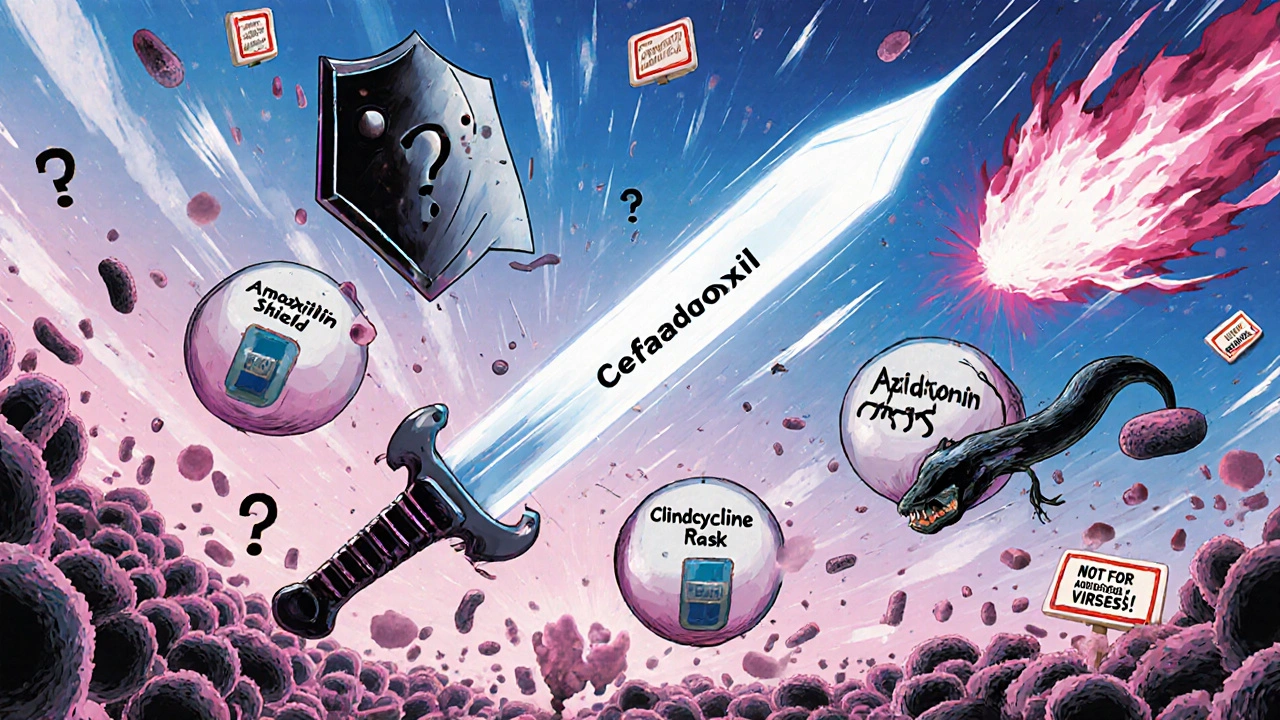When you’re prescribed Duricef (cefadroxil), you might wonder if there’s a better or cheaper option. Maybe your insurance doesn’t cover it, or you had a bad reaction. Or maybe your doctor just mentioned it in passing and you’re doing your own research. Either way, you’re not alone. Many people ask: Duricef - is it the right choice, or is there something else that works just as well?
What is Duricef (Cefadroxil)?
Duricef is the brand name for cefadroxil, a first-generation oral cephalosporin antibiotic. It’s used to treat bacterial infections like strep throat, skin infections (like cellulitis or impetigo), urinary tract infections, and sometimes mild pneumonia. It kills bacteria by breaking down their cell walls - same way penicillin does.
It’s not a broad-spectrum drug like some newer antibiotics. That means it doesn’t work on every kind of bacteria. But for the infections it targets, it’s effective, affordable, and usually well-tolerated. Most people take it once or twice a day, with or without food. A typical course lasts 7 to 10 days.
Side effects are usually mild: nausea, diarrhea, stomach upset. Rarely, people get allergic reactions - rash, swelling, trouble breathing. If you’re allergic to penicillin, you might also react to cefadroxil. About 5-10% of penicillin-allergic patients cross-react with first-gen cephalosporins like this one.
Why Consider Alternatives?
Not everyone can take Duricef. Maybe you’re allergic. Maybe your infection doesn’t respond. Or maybe you’re paying $80 for a 10-day course when a generic alternative costs $12. Insurance formularies change. Pharmacies run out. Doctors switch prescriptions based on local resistance patterns.
There are several antibiotics that treat the same infections as cefadroxil. Some are older and cheaper. Others are newer, broader, or gentler on the gut. The best choice depends on your infection type, medical history, allergies, and cost.
Cefadroxil vs. Amoxicillin
Amoxicillin is the most common alternative. It’s a penicillin-type antibiotic, used for ear infections, sinus infections, strep throat, and urinary tract infections - just like cefadroxil.
Both are taken twice daily. Both are available as generics. Both are considered first-line for many common infections.
But here’s the difference: amoxicillin has better coverage against some bacteria that cause ear and sinus infections, like Haemophilus influenzae. Cefadroxil is slightly stronger against certain skin bacteria like Staphylococcus aureus.
Studies from the Journal of Antimicrobial Chemotherapy show both drugs have similar cure rates for strep throat - around 90%. But amoxicillin is more likely to be covered by insurance and is often cheaper. In 2025, a 10-day course of amoxicillin 500mg costs about $8 at Walmart. Duricef? Around $75 without insurance.
If you’re not allergic to penicillin, amoxicillin is usually the go-to. It’s been used for over 50 years. Millions of doses prescribed. Proven track record.
Cefadroxil vs. Cephalexin
Cephalexin (Keflex) is almost identical to cefadroxil. Both are first-gen cephalosporins. Both work the same way. Both are used for skin and urinary infections.
The main difference? Dosing. Cephalexin is usually taken 3-4 times a day. Cefadroxil is taken once or twice. That’s it.
For people who forget pills, cefadroxil’s simpler schedule is a big win. For others, cephalexin might be the only one covered by insurance. In some areas, cephalexin is stocked more widely.
Side effects? Nearly the same. Diarrhea, upset stomach, rash. Neither is known to cause more yeast infections than the other.
Cost-wise, cephalexin is often cheaper. A 10-day supply of 500mg cephalexin can be as low as $10. Cefadroxil? $50-$80. If your doctor says either is fine, go with the cheaper one.

Cefadroxil vs. Azithromycin
Azithromycin (Zithromax) is a macrolide antibiotic. It’s not a cephalosporin. It’s used for respiratory infections, some skin infections, and STIs like chlamydia.
It’s famous for its “Z-Pak” - five days of pills, but only one pill a day for the first two days, then one every other day. That’s convenient.
But azithromycin doesn’t cover the same bugs as cefadroxil. It’s weak against many staph infections. It’s not first-line for strep throat anymore because of rising resistance.
Also, azithromycin has a higher risk of heart rhythm problems in people with existing heart conditions. The FDA issued a warning in 2013. It’s not something you take casually.
Use azithromycin if you’re allergic to penicillin and cephalosporins. Otherwise, it’s not a direct substitute for Duricef.
Cefadroxil vs. Clindamycin
Clindamycin is an option if you’re allergic to both penicillin and cephalosporins. It’s used for skin infections, dental infections, and some serious bacterial infections.
But here’s the catch: clindamycin has a high risk of causing C. difficile diarrhea - a severe, sometimes life-threatening gut infection. It’s not something you want to take unless absolutely necessary.
Studies show that for skin infections, clindamycin is just as effective as cefadroxil. But because of the C. diff risk, doctors avoid it unless other options are ruled out.
Cost? Clindamycin is cheap - under $15 for a 10-day course. But the risk isn’t worth it unless you have no other choice.
Cefadroxil vs. Doxycycline
Doxycycline is a tetracycline antibiotic. It’s used for acne, Lyme disease, respiratory infections, and some skin infections.
It’s not a good substitute for cefadroxil for strep throat or UTIs. But for acne or tick-borne infections, it’s better.
Doxycycline can make your skin super sensitive to sunlight. You have to avoid tanning beds and wear sunscreen. It also shouldn’t be taken by kids under 8 or pregnant women.
Cost is low - around $10 for a 10-day course. But it’s not interchangeable with Duricef. They treat different bugs.

Which Alternative Is Best for You?
There’s no single best alternative. It depends on your situation.
- For strep throat or UTI, and no penicillin allergy: Amoxicillin - cheaper, proven, widely available.
- For skin infection and you hate taking pills 3x a day: Cefadroxil - once or twice daily dosing wins.
- For skin infection and cefadroxil isn’t covered: Cephalexin - same drug, lower price, same results.
- Allergic to penicillin and cephalosporins: Clindamycin (if infection is mild) or azithromycin (if respiratory).
- For acne or tick bite: Doxycycline - not a substitute, but the right tool for a different job.
Don’t switch antibiotics on your own. If Duricef isn’t working, or you can’t afford it, talk to your doctor. They can check your infection type, your allergy history, and your insurance formulary to pick the best match.
What to Watch Out For
Antibiotics aren’t harmless. Misuse leads to resistance. Taking the wrong one can make your infection worse.
- Never take leftover antibiotics from a past infection. The bug might be different.
- Don’t stop early just because you feel better. Finish the full course.
- Don’t share antibiotics. What works for you might harm someone else.
- If you get severe diarrhea, fever, or abdominal cramps after starting any antibiotic, call your doctor. It could be C. diff.
Also, remember: antibiotics don’t work on viruses. If you have a cold, flu, or most sore throats, you don’t need any antibiotic - even if your doctor says so. Overprescribing is still a problem.
Final Thoughts
Duricef (cefadroxil) is a solid, old-school antibiotic. It’s not flashy, but it works when it’s supposed to. For many people, it’s the right choice.
But it’s not the only choice. Amoxicillin and cephalexin are often better - cheaper, just as effective, and easier to get. Azithromycin and clindamycin have their place, but they’re not direct replacements. Doxycycline? Totally different.
The key isn’t finding the "best" antibiotic. It’s finding the right one - for your infection, your body, and your budget. Ask your doctor: "Is there a generic version? Is there something cheaper that works just as well?" You’ll be surprised how often the answer is yes.
Is cefadroxil the same as amoxicillin?
No, cefadroxil and amoxicillin are different types of antibiotics. Cefadroxil is a cephalosporin; amoxicillin is a penicillin. They work similarly by attacking bacterial cell walls, but they cover slightly different bacteria. Amoxicillin is better for ear and sinus infections, while cefadroxil is slightly stronger against some skin bacteria. Both are effective for strep throat and UTIs.
Can I take cefadroxil if I’m allergic to penicillin?
Maybe, but with caution. About 5-10% of people allergic to penicillin also react to first-generation cephalosporins like cefadroxil. If you had a severe reaction to penicillin - like swelling, trouble breathing, or anaphylaxis - avoid cefadroxil. If your reaction was mild (like a rash), talk to your doctor. They may test you or choose a different antibiotic like azithromycin or clindamycin.
Is cephalexin better than cefadroxil?
They’re nearly identical in effectiveness. The main difference is dosing: cephalexin is usually taken 3-4 times a day; cefadroxil is taken once or twice. Cefadroxil is more convenient. Cephalexin is often cheaper and more widely available. If cost or insurance coverage is an issue, cephalexin is usually the better pick.
Why is Duricef so expensive compared to generics?
Duricef is the brand name. The generic version is cefadroxil. Brand drugs cost more because of marketing, packaging, and patent protections. Generic cefadroxil works the same way and costs a fraction - often under $20. Always ask your pharmacist for the generic unless your doctor specifically requires the brand.
Can I use cefadroxil for a sinus infection?
Yes, but it’s not the first choice. Amoxicillin is preferred for sinus infections because it covers more of the common bacteria involved, like Haemophilus influenzae. Cefadroxil can work if you’re allergic to penicillin, but amoxicillin-clavulanate (Augmentin) is usually better. Always confirm the infection is bacterial - most sinus infections are viral and don’t need antibiotics.
What’s the most common side effect of cefadroxil?
The most common side effect is diarrhea. It’s usually mild and goes away after finishing the course. Nausea and stomach upset are also common. Rare but serious side effects include severe allergic reactions or C. difficile infection, which causes watery diarrhea, fever, and stomach pain. If you get these, stop the drug and call your doctor immediately.







John Rendek
November 2, 2025 AT 00:14For strep or UTIs, amoxicillin is still the gold standard if you’re not allergic. Cheap, effective, and been around longer than most of us have been alive. No need to overcomplicate it.
Sonia Festa
November 2, 2025 AT 01:00Ugh, I took cephalexin once and it turned my gut into a war zone. Cefadroxil? Zero issues. Maybe it’s the dosing? Who knows. But I’m sticking with the once-a-day magic.
Amina Kmiha
November 2, 2025 AT 08:48Let’s be real-Big Pharma doesn’t want you to know cefadroxil costs $12 as a generic. They push Duricef because it’s got a shiny label and a fancy name. Same pill. Different price tag. 💸
Ryan Tanner
November 4, 2025 AT 03:44My grandma took cephalexin for 40 years and never had a problem. If your doc says either works, go with the one your pharmacy has in stock. No need to stress.
Emily Barfield
November 4, 2025 AT 20:34It’s fascinating, isn’t it?-how we’ve reduced human health to a cost-benefit spreadsheet… antibiotics as commodities, side effects as footnotes, life-saving drugs as line items on a pharmacy receipt. Where did our trust in medicine go? Did we trade it for coupons? Are we now just consumers of biological machinery, choosing between $8 and $75 versions of the same cellular sabotage? I wonder… if we stopped treating illness like a grocery run, would we even need these comparisons?
Sara Allen
November 5, 2025 AT 16:34why do they let indians make antibiotics? i heard they use dirty water to make the pills and then ship them here. i got sick after taking some generic stuff from india. its all a scam. america should make its own drugs. stop trusting foreign pills. they dont even wash their hands.
Vrinda Bali
November 7, 2025 AT 00:50Have you ever stopped to consider that the entire antibiotic industry is a controlled distraction? The CDC, WHO, and Big Pharma are all part of the same cabal-pushing antibiotics to keep us dependent while quietly seeding antibiotic resistance to justify the next generation of expensive, patented drugs. Cefadroxil? It’s not about efficacy-it’s about control. They want you to believe you need a new pill every time you sneeze. But the truth? Your immune system has been fighting infections since before you were born. And it’s been lied to.
They don’t want you to know that natural remedies-garlic, honey, colloidal silver-have been proven in peer-reviewed studies to outperform antibiotics in mild cases. But those studies? Buried. Suppressed. Classified under "non-pharmaceutical interference." The FDA doesn’t approve them because they can’t be patented. And that’s the real crime.
And don’t even get me started on "generic" labels. That’s just a marketing trick. The same factory. The same inactive ingredients. But now it’s "cheap" so you feel smart for buying it. You’re not smart-you’re manipulated. They want you to think you’re saving money when you’re actually funding the machine that’s making you sick.
Next time your doctor prescribes anything, ask: "Who profits?" And if they hesitate? Walk out. Your body is not a vending machine.
Albert Schueller
November 8, 2025 AT 18:06Actually, the data on penicillin cross-reactivity is overstated. Recent studies (2023, JAMA) show less than 2% risk with first-gen cephalosporins-not 5-10%. The old numbers are from the 80s and haven’t been updated in guidelines. Doctors are still scare-touting outdated stats. It’s lazy. And it’s denying people safe, affordable options.
Jessica Adelle
November 10, 2025 AT 06:55It is profoundly disconcerting that the American public has become so commodified in its approach to pharmaceuticals. The notion that one ought to select an antibiotic based on cost, rather than clinical appropriateness, is a moral failure of the highest order. One does not choose a life-saving intervention as one would select a brand of laundry detergent. Such a mindset reflects a systemic collapse of medical literacy-and a dangerous erosion of the physician-patient relationship.
Sai Ahmed
November 12, 2025 AT 01:51They’re all the same. The government, the pharma companies, the doctors-they all get paid the same way. You think they care if you get better? They care if you keep coming back. That’s why they push pills. Not because you need them. Because you’re profitable.